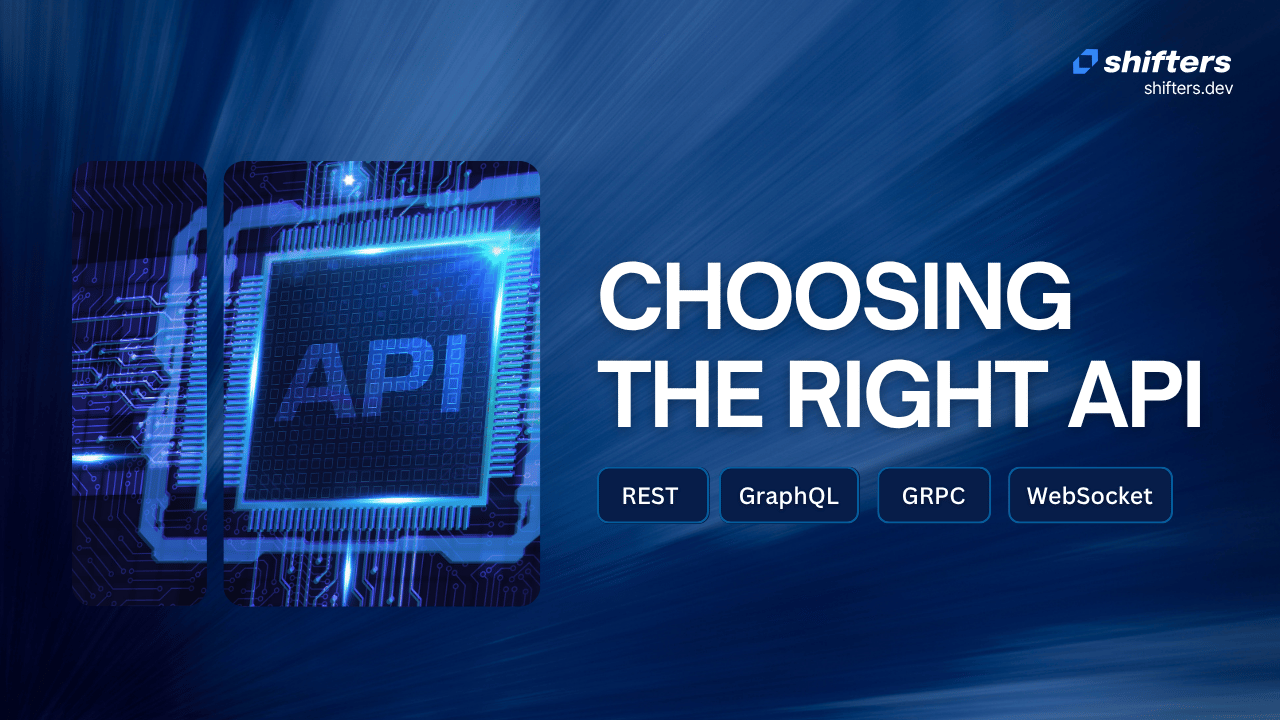Building modern applications means dealing with different systems talking to each other. Think of it like choosing the right communication method - sometimes you need a phone call, sometimes a text message works better. The same goes for API.
Let me walk you through four popular ways applications communicate with each other, and when you should use each one.
What is REST and why everyone uses it
REST stands for Representational State Transfer, but don't worry about the fancy name. It's basically how most websites and apps talk to servers today.
Think of REST like visiting different pages on a website. You go to specific addresses (URLs) to get specific information. Want to see products? Go to /products. Want to see a specific product? Go to /products/123.
How REST works
REST follows some simple rules that make it reliable:
Everything has an address: Every piece of information lives at a specific URL. Just like every house has an address, every resource in your API has one too.
It's stateless: Each request you make contains everything the server needs to understand what you want. The server doesn't remember your previous requests.
You can cache responses: If you ask for the same information twice, the system can give you the saved answer instead of doing the work again.
It's layered: Your request might go through several systems before reaching the final server, but you don't need to worry about that.
When to use REST
REST works well when internet bandwidth is limited, and you need a simple, easy-to-build, and easy-to-understand solution. It is ideal when multiple different applications will use the same API, and when you want to cache responses to improve performance and speed.
REST example
Let's say you're building an online store. To get all product categories, you'd make this request:
GET /categories
The server sends back:
[
{ "id": 1, "name": "Electronics" },
{ "id": 2, "name": "Clothing" },
{ "id": 3, "name": "Food" }
]
To get products from the Electronics category:
GET /categories/1/products
And you get:
[
{ "id": 1, "name": "iPhone X", "price": 999.99, "category_id": 1 },
{ "id": 2, "name": "MacBook Pro", "price": 1499.99, "category_id": 1 },
{ "id": 3, "name": "iPad Pro", "price": 799.99, "category_id": 1 }
]
Simple and straightforward.
What is GraphQL and why use it
GraphQL is like having a smart assistant who gives you exactly what you ask for - no more, no less.
With traditional REST, if you want someone's name and email, you might get their entire profile including address, phone number, and birthday. With GraphQL, you ask for just the name and email, and that's all you get.
How GraphQL is different from REST
The biggest difference is control. With REST, the server decides what information to send you. With GraphQL, you decide exactly what you want.
REST uses different URLs for different data. GraphQL uses one URL, but you write a query describing exactly what you need.
When to use GraphQL
GraphQL is ideal when you need to fetch data from multiple sources or serve different clients with varying data needs. It helps reduce over-fetching by allowing you to request only the data you need. It’s also very useful during rapid prototyping due to its flexibility.
GraphQL example
Using our store example, here's how you'd get categories with GraphQL:
query GetCategories {
categories {
name
id
}
}
Response:
{
"data": {
"categories": [
{ "name": "Electronics", "id": "1" },
{ "name": "Clothing", "id": "2" },
{ "name": "Books", "id": "3" }
]
}
}
For products in Electronics:
query GetProductsForCategory($categoryId: ID!) {
category(id: $categoryId) {
name
products {
name
price
}
}
}
Response:
{
"data": {
"category": {
"name": "Electronics",
"products": [
{ "name": "iPhone", "price": "$999.99" },
{ "name": "Macbook Pro", "price": "$1,299.99" },
{ "name": "Smartwatch", "price": "$349.99" }
]
}
}
}
Notice how you get exactly what you asked for - just names and prices, not IDs or other details.
GraphQL vs REST: the real difference
Here's something interesting - REST can actually do most of what GraphQL does. You could make a REST endpoint like:
GET /categories/1/products?fields=title,price
And build your own logic to return only those fields.
GraphQL really shines when you're combining data from multiple places, like in microservice architecture, or when you have lots of unnecessary data transfer.
What is WebSocket and why use it
WebSocket is like having a phone conversation instead of sending letters back and forth. Once you establish the connection, both sides can talk whenever they want.
Unlike REST where you ask a question and get an answer, WebSocket keeps the line open. The server can send you updates without you asking, and you can send messages anytime.
When to use WebSocket
WebSocket is the right choice when your application requires real-time, two-way communication. It’s perfect for use cases like chat apps, multiplayer games, or live dashboards where the server needs to push updates to the client instantly.
WebSocket limitations
The main downside is complexity. WebSocket requires more server resources because it keeps connections open. It also needs both TCP and HTTP support to get started.
WebSocket example
Here's how our store might work with WebSocket:
const socket = new WebSocket('ws://localhost:8080');
// Connection opened
socket.addEventListener('open', (event) => {
socket.send(JSON.stringify({ type: 'getCategories' }));
socket.send(JSON.stringify({ type: 'getProducts', categoryId: 1 }));
});
// Listen for messages
socket.addEventListener('message', (event) => {
const data = JSON.parse(event.data);
switch (data.type) {
case 'categories':
displayCategories(data.categories);
break;
case 'products':
displayProducts(data.products);
break;
}
});
The server can send updates instantly - new products, price changes, or inventory updates - without the client asking.
What is gRPC and why use it
gRPC is like having a direct hotline between your services. It's built for speed and efficiency, especially when your services need to talk to each other frequently.
Major companies like Google, Netflix, and IBM use gRPC because it's incredibly fast and reliable for internal service communication.
When to use gRPC
gRPC is best when performance is critical and you're working with internal services, especially in a microservices setup. It enables fast, efficient communication with strongly typed contracts and is well-suited for backend systems that don’t need to be accessed directly by web browsers.
Note: gRPC doesn't work well in web browsers because browsers don't fully support HTTP/2 in the way gRPC needs.
gRPC example
First, you define your service in a .proto file:
syntax = "proto3";
service Store {
rpc GetCategories (google.protobuf.Empty) returns (Categories);
rpc GetProducts (CategoryId) returns (Products);
}
message Categories {
repeated Category categories = 1;
}
message Category {
int32 id = 1;
string name = 2;
}
message CategoryId {
int32 id = 1;
}
Then your client code looks like:
var channel = new Channel("localhost:50051", ChannelCredentials.Insecure);
var client = new Store.StoreClient(channel);
// Get categories
var categories = client.GetCategories(new Empty());
foreach (var category in categories.Categories)
{
Console.WriteLine($"ID: {category.Id} Name: {category.Name}");
}
// Get products for first category
var categoryId = categories.Categories[0].Id;
var products = client.GetProducts(new CategoryId { Id = categoryId });
foreach (var product in products.Products)
{
Console.WriteLine($"ID: {product.Id} Name: {product.Name}");
}
gRPC requires you to define exactly what messages you're sending and receiving. This might seem verbose, but it makes your API contract crystal clear and catches errors early.
Mixing and matching
You don’t have to stick to just one technology. Many successful applications combine multiple approaches to get the best results.
For example, you might use REST for your main public API, GraphQL as a gateway to unify multiple REST services, WebSocket for real-time features like live notifications or chat, and gRPC for efficient internal communication between services.
The key is to understand what each technology is best at and apply it where it makes the most sense. Always remember: the "best" technology is the one that solves your specific problem effectively while keeping your codebase clean and maintainable. Start with something simple, and only add complexity when it's truly necessary.
Conclusion
There is no single "best" choice when selecting between REST, GraphQL, WebSocket, or gRPC; it all depends on your specific needs. REST is ideal for simple, widely supported APIs and works well when multiple clients need access and caching is important. GraphQL shines when you require flexible and precise data queries from multiple sources, especially during rapid development. WebSocket is the clear choice for applications needing real-time, two-way communication, such as chat or live updates. Meanwhile, gRPC excels in high-performance environments, particularly for internal microservices where efficiency and strong typing are priorities. Understanding the requirements of your project will help you pick the right technology for the best results.



